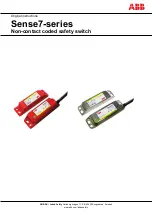
Root Port
: The port selected on non-root bridges to provide the lowest root path cost. There is
only one root port in each non-root bridge.
Designated Port
: The port selected for each LAN segment to provide the lowest root path cost
from that LAN segment to the root bridge.
Port Priority
: The port priority can be set to an integral multiple of 16 in the range of 0~240.
The lower value priority has the higher priority. The port with the higher priority has more
chance to be chosen as the root port.
The following network diagram shows the sketch map of spanning tree. Switch A, B and C are
connected together in order. After STP generation, switch A is chosen as the root bridge, the
path from port 2 to port 6 is blocked.
Bridge: Switch A is the root bridge in the whole network; switch B is the designated bridge of
switch C.
Port: Port 3 is the root port of switch B and port 5 is the root port of switch C; port 1 and 2
are the designated ports of switch A and port 4 is the designated port of switch B; port 6 is
the blocked port of switch C.
Figure 8-1 Basic STP diagram
STP Timers
Hello Time:
Hello Time is 2 seconds. It specifies the interval to send BPDU packets. It is used to test the
links.
Max Age:
Max Age ranges from 6 to 40 seconds. It specifies the maximum time the switch can wait
without receiving a BPDU before attempting to reconfigure.
Forward Delay:
Forward Delay ranges from 4 to 30 seconds. It specifies the time for the port to transit its state
after the network topology is changed.
When the STP regeneration caused by network malfunction occurs, the STP structure will get
some corresponding change. However, as the new configuration BPDUs cannot be spread in
the whole network at once, the temporal loop will occur if the port transits its state immediately.
Therefore, STP adopts a state transit mechanism, that is, the new root port and the designated
106
















































